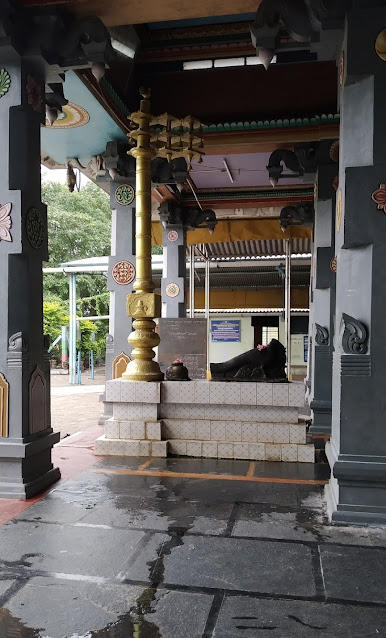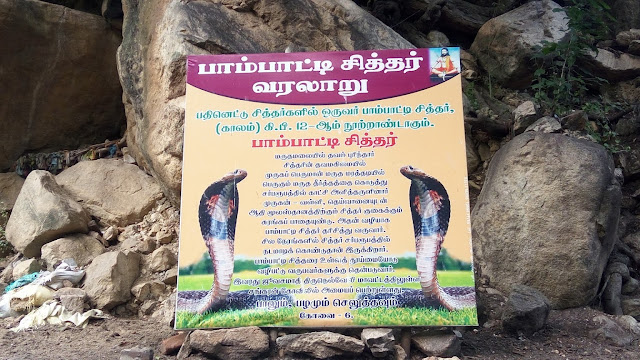Marudamalai Murugan Temple –
The Temple Complex
The temple is situated at the top of a 600 feet tall hill on the western ghats. The temple is situated on the eastern face of the hill compare to the other Murugan temples on the hills. The hill temple can be accessed through flight of 837 steps. The hill path is provided with mandapams at regular intervals for the devotees to take rest during their arduous journey from the foot hill to the temple at hill top. It can also be accessed through motorable road.
The hill temple is facing towards east with seven tiered rajagopuram. Valampuri Vinayaga, peacock faced ornamental lamp Stone Dwaja Sthambam, metal Dwaja Sthambam, Balipeedam and peacock mount can be seen immediately after the rajagopuram. The hill temple consists of sanctum, ardha mandapam and mukha mandapam. Varadaraja shrine can be seen in the mukha mandapam. Vinayaga and Veerabhadra can be seen at the entrance of the sanctum on either side.
The sanctum enshrines an image of presiding deity, Marudamalai Andavar / Marudachalapathi / Dhandayuthapani / Marudhachala Moorthy. The image is made of granite and is about five feet tall. His right hand holds the staff (Danda) and the left-hand rests on the hip. His weapon Vel (spear) is placed across the deity. He sports a turban on the head with a tuft behind. The image bears a close resemblance to the deity at Palani. It is said that the idol for Lord Muruga was made by Pampatti Siddhar.
The sanctum is flanked by
Patteeswarar shrine on the right side and Maragadambikai
shrine on the left side. Thus, the temple forming Somaskanda arrangement. Dakshinamoorthy,
Lingodbhava and Durga are the koshta idols located around the Patteeswarar
shrine. Chandikeswarar shrine can be seen in his usual location. Navagrahas
shrine is situated opposite to the Maragadambikai shrine in the outer prakaram.
Aadhi Moolasthanam:
The original deity of this
temple is enshrined in Aadhi Moolasthanam. Lord Murugan along with his consorts
Valli and Devasena in Swaymbhu form (Linga form) in this shrine. It is said
that these Swayambhu idols are the deities referred in the Perur Puranam. This
shrine is situated on the southern side of the outer prakaram. There is a crack
behind the Swayambu Muruga. The Swayambhu Moorthy of Valli is taller than Devasena.
The pooja is first performed to this Swayambu Murugan and then to the Murugan
in the present sanctum. Milk abishekam is performed to this Muruga during
Krithikai star days.
Pampatti Siddhar Cave Temple:
For brief details, please refer below link;
Than Thondri Vinayaga Shrine:
There is a shrine for Than
Thondri Vinayaga at the foot hills exactly where the steps to the hill temple
begins. The deity is said to be Swayambhu Moorthy (self-manifested). Than
Thondri Vinayagar is praised in the Marudamalai Than Thondri Pathigams of Perur
Puranam. He is depicted with an elephant head only without body. His tusk is
pointed towards the hill top shrine.
There is another idol of
Vinayaga can be seen in this shrine. The first puja is performed to the
Swayambu Vinayaka and then the next Vinayaga. Special pujas are performed to this
Vinayaka on Krithikai, Sashti, Visakam and New Moon days similar to Muruga.
Hence, this Vinayaka is praised as Thambiku Ukantha Vinayagar (beloved brother Vinayaka).
It is customary to worship this Vinayaga before proceeding on the steps.
Pathinettam Padi:
The 18 steps on the way to the
hill step immediately after the Thanthondri Vinayaga is famously called as
Pathinettam Padi. This Pathinettam Padi is considered equivalent to 18 steps of
Sabarimalai. Those who could not undertake the strenuous trek to the Sabari
Hills offer worships here and fulfill their vows.
Idumban Shrine:
Idumban Shrine is situated on the
way to the hill temple. The image of the deity is carved on a huge round rock.
He is depicted carrying a Kavadi. Childless couple worship Idumban and offer
toy cradles for child boon. His mount, tiger can be seen facing towards the
Idumban shrine.
Kuthirai Kulambukkal:
The hoof marks of horse called Kuthirai
Kulambukkal can be found on a rock on the way to the temple. This hoof marks
are enshrined in a mandapam. It is believed that the horse on which Lord Muruga
rode and chased the robbers might have imprinted the hoof marks on the rock. There
is a sculpture depicting Lord Muruga on a horse.
Pancha Vriksham:
There is a cluster of five trees
(Arasu, Vembu, Athi, Vanni and Korakkattai) closely intertwining one another. An idol of
Vinayaga called Pancha Vriksha Vinayaga can be seen under the tree. Lord Muruga
can be seen by his side graces with his weapon Vel and his mount peacock. It is
believed that Siddhas in aroopa form stays here and perform meditation.
Saptha Kannikas Shrine:
Shrine of Saptha Kannikas (seven
maidens) can be seen on way to the Pampatti Siddhar Shrine. It is situated on
the banks of Marudha Theertham. Marudha Theertham is also called as Kanni
Theertham because of the presence of this shrine.
Ucchipillaiyaar Shrine:
This shrine is situated at about
2 Kms to the north of the main shrine. The idol has been installed recently.
Theerthams:
Theerthams associated with this temple are Marudha Theertham (Kanni Theertham), Pampatti Theertham and Skanda
Theertham. It is said that the Marudha Theertham springs from the bottom of a Marudha
tree and the waters from this theertham is used for the abishek of Lord Muruga.
Sthala Vriksham:
Sthala Vriksham is Marudham Tree. It is situated in front of the Pampatti Siddhar shrine.










